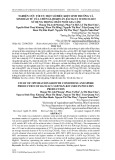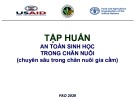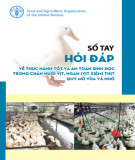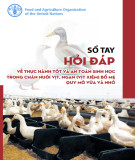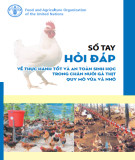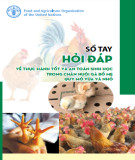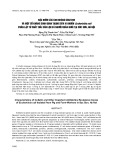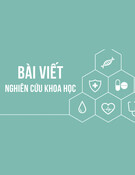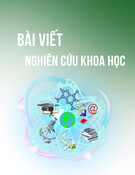
108 Nong Lam University, Ho Chi Minh City
The Journal of Agriculture and Development 23(Special issue 1) www.jad.hcmuaf.edu.vn
Effects of dietary supplementation of shrimp head and shell by-products on growth performance and
incidence of diarhea in fattening pigs from 96 to 164 days of age
Anh T. N. Dang1, Hai T. Nguyen1, Cuong K. Nguyen2, Duong T. Do3, Mi T. T Bui3, & Khang N. Duong4*
1Department of Animal Production, Nong Lam University, Ho Chi Minh City, Vietnam
2Department of Veterinary Biosciences, Nong Lam University, Ho Chi Minh City, Vietnam
3Department of Genetics and Animal Breeding, Nong Lam University, Ho Chi Minh City, Vietnam
4The Research and Technology Transfer Center, Nong Lam University, Ho Chi Minh City, Vietnam
ARTICLE INFO ABSTRACT
Research Paper
Received: August 29, 2024
Revised: October 14, 2024
Accepted: October 18, 2024
Keywords
Diarrhea
Fattening pigs
Growth performance
Shrimp heads and shell
Shrimp hydrolysate powder
*Corresponding author
Duong Nguyen Khang
Email:
duongnguyenkhang@hcmuaf.edu.vn
The objective of this study was to evaluate effects of dietary
supplementation of shrimp head and shell by-products on growth
performance and incidence of diarhea in fattening pigs from
August 2023 to October 2023 at the pig farm in Thoai Son district,
An Giang province. A total of 90 crossbred pigs [(Duroc x Pietrain)
x (Landrace x Yorkshire); 96 days old] were assigned to 1 of 3
treatments with 5 replicate pens of 6 pigs each according to sex,
litter origin, and weight in a randomizedcompleteblockdesign
(RCBD). The 3 dietary treatments included (1) Basal diet (control),
(2) Basal diet + 3 g/kg shrimphydrolysate powder (SH) and (3)
Basal diet + 10 g/kg shrimp heads and shells meal (SM). The results
showed that there were no significant differences in the average
body weight (BW) and average daily gain (ADG) among the 3
treatments (P > 0.05). Similarly, pigs fed the SH diet (2.99) and SM
diet had the same feed conversion ratio (FCR) of pigs (P = 0.767)
as those fed the control diet (3.04) during the whole period from
96 to 164 days of age. Furthermore, no significant differences (P >
0.05) were found in the average daily feed intake (ADFI) and the
diarrhea incidence among the 3 treatments. Briefly, the results in
the current study suggest that dietary supplementation of shrimp
head and shell by-products (shrimp hydrolysate powder, or shrimp
heads and shell meal) seem to have no positive effects on growth
productivity (BW, ADG, ADFI and FCR) and incidence of diarrhea
in fattening pigs during 96 - 164 days of age.
Cited as: Dang, A. T. N., Nguyen, H. T., Nguyen, C. K., Do, D. T., Bui, M. T. T., & Duong, K. N. (2024).
Effects of dietary supplementation of shrimp head and shell by-products on growth performance
and incidence of diarhea in fattening pigs from 96 to 164 days of age. The Journal of Agriculture and
Development 23(Special issue 1), 108-115.

Nong Lam University, Ho Chi Minh City 109
The Journal of Agriculture and Development 23(Special issue 1) www.jad.hcmuaf.edu.vn
2021). In Vietnam, however, the practical benefits
of by-products from the shrimp industry in pig
production are still limited in both academic
research and feasible applications.
Therefore, the objective of the current study
was to determine the effects of one product that
contained by-products from shrimp (head and
shells) on growth performance, feed consumption
and diarrhea disease in pig production at the
fattening stage.
2. Materials and Methods
2.1. Location
The study was conducted at the pig farm
of Thoai Son district, An Giang province from
August, 2023 to October, 2023.
2.2. Experimental design, animals and housing
A total of 90 crossbred pigs [(Duroc x Pietrain)
x (Yorkshire - Landrace)] at 96 days of age with
an initial average body weight (BW) of 43.67
1.1 kg were assigned to a randomized complete
design with three dietary treatments (five
replicate pens per treatment, three barrows and
three gilts per pen). The average BW (P > 0.05),
pigs’ sex and litter were almost similar among the
3 treatments. Three dietary treatments consisted
of (1) the basal diet (control), (2) basal diet
supplemented with 3 g/kg shrimp hydrolysate
powder (SH), and (3) basal diet supplemented
with 10 g/kg shrimp head and shell meal (SM)
(Both SH and SM provided by a commercial
company) (Table1).
1. Introduction
Shrimp processing for export releases many
by-products during the production process; waste
from the shrimp processing industry mainly
includes the head, chest, carapace, and tail,
accounting for 50% of the whole shrimp (Thiago
et al., 2012). Taking advantage of available by-
products from the shrimp production industry to
become a source of protein-rich feed ingredients
is a direction in line with the circular farming
trend that is being interested in the livestock
farming practice to solve the problem of
shortage of feed ingredients and reduce negative
impacts on the ecosystem. Chitin is the primary
component in shrimp shells, making up 15 - 40%
of their composition (Abuzar et al., 2023). This
substance can be extracted through a process
known as the chitin recovery method, resulting
in a product commonly used in livestock farming
called chitosan; after hydrolyzing chitosan with
enzymes (Pham et al., 2017) to create shrimp-
derived oligosaccharide higher the biological
value. Recently, it has been demonstrated that
the feed conversion ratio (FCR) (Han et al., 2007)
and the average daily gain (ADG) (Chatchai
et al., 2019) of fattening pigs were significantly
improved when they fed daily diets contained
chitosan at 1 g/kg and 0.3 g/kg, respectively.
Furthermore, it has been reported that shrimp
hydrolysate powder produced from shrimp heads
and shells by the chemical hydrolysis method
is being studied and proven to be effective in
livestock farming (Liu et al., 2021; Ngo et al.,
2021). Increasing the number of short-chain
peptides in daily diets supported easier and better
absorption in the digestive tract of livestock
(Ngo et al., 2021); as well as the appearance of
many amino acids that stimulate the appetite of
livestock (taurine, glycine, alanine) (Liu et al.,

110 Nong Lam University, Ho Chi Minh City
The Journal of Agriculture and Development 23(Special issue 1) www.jad.hcmuaf.edu.vn
Table 1. Experimental design
Treatment Control SH SM
Pigs per pen, n 6 6 6
Replicate, pen 5 5 5
Total pigs 30 30 30
Duration, days 68 68 68
Pigs’ dietary by-products shrimp addition, g/kg feed 0 3 10
SH: Shrimp hydrolysate powder; SM: Shrimp heads and shells meal.
Pigs were housed in an environmentally
controlled building. Each pen measured 2 x 3
m in size with a slatted floor and had two nipple
waterers. The chemical compositions of shrimp
hydrolysate powder was shown in Table 2.
Table 2. Chemical and amino acid compositions of shrimp hydrolysate powder
Nutrients Levels Essential amino
acids
Percentage
(%)
Non-essential
amino acids
Percentage
(%)
Dry matter 86% Arginine 1.22 Glutamic acid 2.33
Crude protein 30% Histidine 0.56 Aspartic acid 1.47
Astaxanthin 11.45 ppm Lysine 0.95 Glycine 1.43
Leucine 1.43 Proline 1.01
Methionine 0.46 Cystine 0.23
Threonine 0.83 Valine 1.14
Isoleucine 0.90
Phenyl alanine 1.04
2.3. Experimental condition
2.3.1. Experimental diets and animal feeding
The daily mash feed as a basal diet was
formulated with chemical compositions as
nutrient requirements for the fattening pigs
recommended by the NRC (2012) from
common ingredients (Table 3) (produced by
An Giang Agricultural Import-Export Joint
Stock Company). Although the additional
shrimp-derived protein was added to the basal
diet, which was consistent with protein in the
basal diet.
All pigs were fed twice a day (7:30 and 14:00,
ad libitum) with distinguishing diets for each
treatment. The experimental condition was set
up in a temperature-controlled room and had
free access to water and feed throughout the trial.

Nong Lam University, Ho Chi Minh City 111
The Journal of Agriculture and Development 23(Special issue 1) www.jad.hcmuaf.edu.vn
by counting pig days with diarrhea score of 3 or
greater during the whole experimental duration.
2.5. Statistical analysis
Data were analysed as a randomized complete
block design by ANOVA using the GLM
procedure (Minitab 16.2). The pen was considered
the experimental unit. The incidence of diarrhea
was compared by χ2 analysis. Treatment effects
were considered significant at P < 0.05.
Table 3. Ingredients and chemical compositions of the basal diets
Items Percentage
Ingredients Corn bran 35.58
Rice bran 10
Casava root meal 12
Soybean waste 20
Soybean meal 20
Minerals 1.1
Premix 1.1
Chemical compositions ME, Kcal/kg 3,050
CP, % 16.4
Lysine, % 0.82
Met + Cys, % 0.48
Threonine, % 0.58
Tryptophan, % 0.19
2.4. Sample collection and measurements
The BW and feed consumption were measured
at the initial and final times of this experiment.
Then, the ADG, average daily feed intake (ADFI),
and FCR were calculated.
The incidence of diarrhea was recorded on a
daily basis and based on fecal scores were based
on 1 to 5 scale: 1 = normal; 2 = moist feces; 3
= mild diarrhea; 4 = severe diarrhea; 5 = watery
diarrhea. The incidence of diarrhea was calculated
3. Results and Discussion
3.1. Growth performance
Table 4. Effect of dietary Shrimp hydrolysate powder (SH) and Shrimp heads and shells meal (SM)
supplementation on body weight (kg/pig) of fattening pigs
Days of age Treatments1
SEM P
Control SH SM
96 42.41 44.41 44.20 0.095 0.602
135 69.93 71.75 72.94 0.131 0.695
164 91.84 96.95 95.28 0.225 0.494
15 pens/treatment and 6 pigs/pen.

112 Nong Lam University, Ho Chi Minh City
The Journal of Agriculture and Development 23(Special issue 1) www.jad.hcmuaf.edu.vn
contains many amino acids and di/tripeptides
that help animals absorb directly, save energy for
digestion, and at the same time stimulate appetite
and bring a delicious feeling (Ngo et al., 2021).
There was no significant difference in the ADG
among the 3 treatments in the period from 96 to
134 days of age (P = 0.792; Table 5), although pigs
fed diets added the SH had numerically greater
ADG (0.90 kg/day) than those of the SM (0.80
kg/day) and control treatments (0.78 kg/day) in
the period of 135 - 164 days of age (P = 0.160).
Besides, the ADG of pigs was not significantly
different among the three treatments (control, SH,
and SM treatments at 0.72, 0.77 and 0.75 kg/day,
respectively) in the period of 96 - 164 days of age.
Therefore, dietary supplementation of SH at 3 g/
kg or SM at 10 g/kg has no positive impact on the
ADG of the fattening pigs in the fattening period.
There were no significant differences in BW
among the 3 treatments at 96 days of age (P =
0.602; Table 4). Similarly, dietary supplementation
at 3 g/kg SH or 10 g/kg SM did not significantly
increase (P = 0.695) the BW at 135 days of age
(71.75 and 72.94 kg, respectively) compared
with that of the control (69.93 kg/pig). The BW
of the SH treatment was also similar (96.95
kg/pig) to those of the SM (95.28 kg/pig) and
control treatments (91.84 kg) at the end of the
experimental period (P = 0.494). Therefore, our
current results indicated that dietary inclusion of
SH at 3 g/kg or SM at 10 g/kg in the fattening
period seems to have no positive impact on the
BW of the fattening pigs. In contrast, Liu et al.
(2021) demonstrated that shrimp heads are a
source of unsaturated fatty acids, crude protein,
essential amino acids, macro and micro minerals.
It also reported that hydrolyzed shrimp protein
Table 5. Effect of dietary Shrimp hydrolysate powder (SH) and Shrimp heads and shells meal (SM)
supplementation on average daily gain (kg/day) of fattening pigs
The period
(days of age)
Treatments1
SEM P
Control SH SM
96 - 134 0.68 0.68 0.72 0.002 0.792
135 - 164 0.78 0.90 0.80 0.006 0.160
96 - 164 0.72 0.77 0.75 0.002 0.606
15pens/treatment and 6 pigs/pen.
SH at 3 g/kg or SM at 10 g/kg has no beneficial
effect on the ADFI in the fattening period period.
On the contrary, previous studies indicated
that shrimp heads contain about ten types of
distinguishing proteases, including myofibril-
associated serine proteinase, chymotrypsin,
cathepsin B, pepsin, serine protease, trypsin,
metalloprotease, cathepsin L, collagenase, and
calpain (Xu et al., 2012) and contain many
amino acids that stimulate the appetite of pigs,
especially accounted for 10% glutamic acid (Liu
et al., 2021), leading to increase the average daily
feed intake of pig fed dietary SH supplementation
(Xu et al., 2012; Liu et al., 2021).
3.2. Average daily feed intake (ADFI)
There were no significant differences (P
> 0.05; Figure 1) in the ADFI among the 3
treatments in the period from 96 to 134 days
of age (control, SH or SM at 1.87, 1.92 or 1.89
kg/day, respectively) and from 135 to 164 days
of age (control, SH and SM at 2.70, 2.79 or 2.70
kg/day, respectively). Besides, during the whole
experimental period, pigs fed diets supplemented
the SH or the SM did not significantly increase
the ADFI (2.30 or 2.24 kg/day, respectively) (P
= 0.157) compared with that of the control (2.19
kg/day). Therefore, dietary supplementation of



